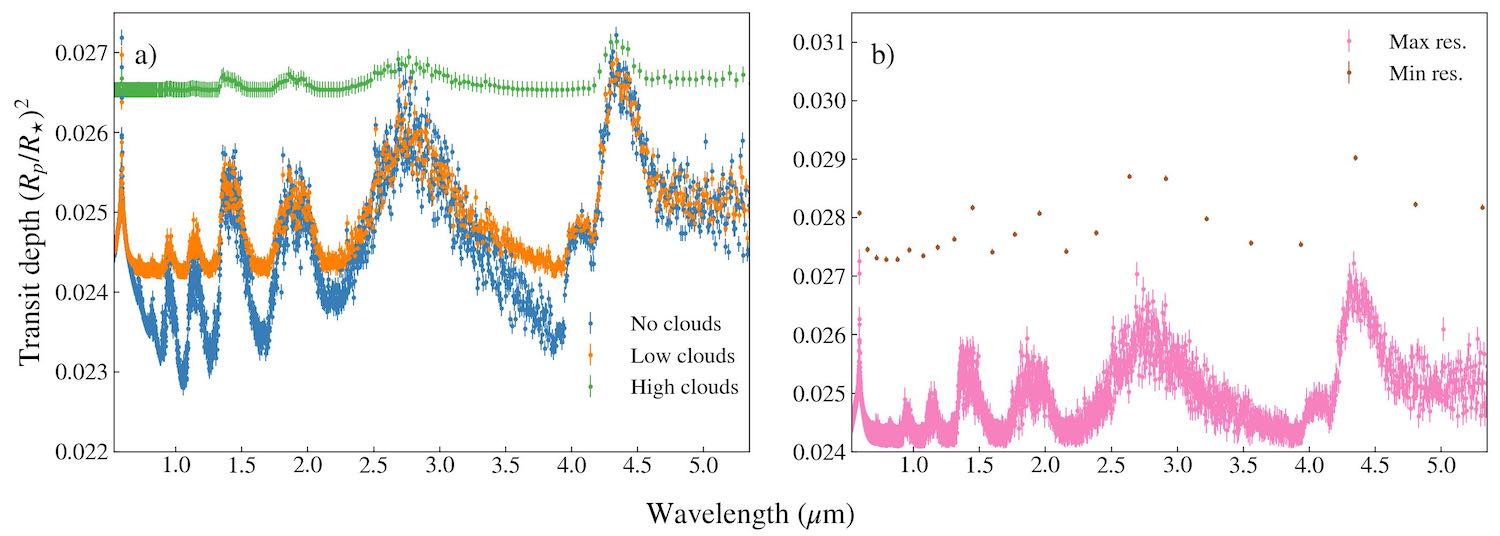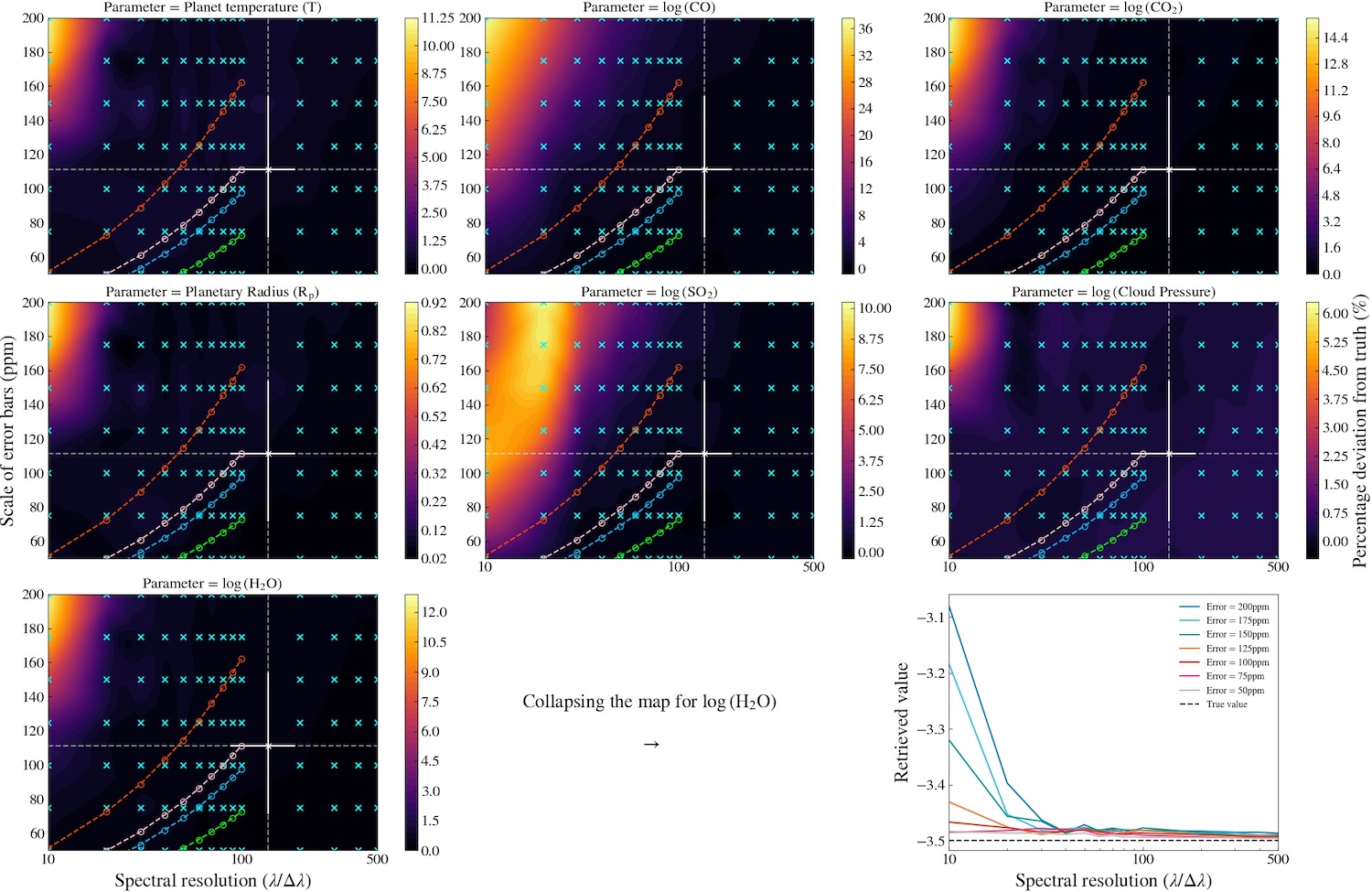- 1Physics and Astronomy, University College London, London, United Kingdom of Great Britain – England, Scotland, Wales (jack.davey.22@ucl.ac.uk)
- 2Physics and Astronomy, University College London, London, United Kingdom of Great Britain – England, Scotland, Wales
With the James Webb Space Telescope (JWST) offering higher resolution data in space-based transmission spectroscopy, understanding the capabilities of our current atmospheric retrieval pipelines is essential. These new data cover wider wavelength ranges and at much higher spectral resolution than previous instruments have been able to offer. Therefore, it is often appealing to bin spectra to fewer points, better constrained in their transit depth, before using them as inputs for atmospheric retrievals. However, little quantitative analysis of the trade-off between spectral resolution and signal-to-noise ratio has been conducted thus far.
As such, we produce a simulation to mimic the observations of WASP-39b by the NIRSpec PRISM instrument on board JWST and assess the accuracy and consistency of retrievals while varying resolution and the average photometric error in these spectra. We repeat this analysis on three different simulation setups where each includes an opaque cloud layer at a different height in the atmosphere, varying the scale height of features seen in the resulting spectra. See figure 1 for examples of these spectra.

FIGURE 1: The simulated spectra used in the investigation. Panel a demonstrates the spectra with the three different cloud decks used in the investigation while panel b shows the extreme cases of binning considered in our resolution-error grid.
In general, we see the expected trend in our sensitivity maps; as resolution increases and the photometric error decreases, the accuracy of our retrievals improves. Clear boundaries between well and poorly retrieved regions are evident in these maps but the position of this boundary in resolution-error space and the difference in accuracy between these regions is heavily dependent on the cloud deck. See figure 2 for the example of retrievals run on the low cloud case.
We find that a much greater resolution is needed in the case of a high cloud deck since features are already heavily muted by the presence of the clouds. In the other two cases, there are large ‘safe’ zones (darker regions) in the parameter space and the average resolution and error of the NIRSpec PRISM observations of WASP-39b fall well within these regions.

FIGURE 2: The sensitivity maps for the retrieval grid with the low cloud spectrum. Blue crosses mark the positions of retrievals in the grid, the white marker indicates the position of the JWST NIRSpec PRISM observations of WASP-39b and the curved dashed lines indicate approximate ‘binning paths’. In the lower right panel we also present a collapsed version of the map for the log-abundance of water. In this case, the x-axis is unchanged but the y-axis marks the actual retrieved value for this parameter and the coloured lines show the trends for different sizes of error bars.
While this probes a specific case we also plot ‘binning paths’ in the resulting sensitivity maps to demonstrate the best attainable atmospheric parameter estimations starting from the position of the real JWST Early Release Science observation. If these maps can be generalised, binning paths could help to guide and inform future observations.
We also compare the retrievals in this grid (which use a constant resolution and have equal error bars on all points across the wavelength range of the spectrum) with a more realistic case by binning down from the ERS data. We find these results to be in good agreement with the trends presented in our sensitivity maps.
Additionally, we consider the correlation between parameters in these retrievals. It is expected that some parameters will show a strong correlation due to the similar effects that they cause in the spectrum but we focus on cases where we see a changing level of correlation as resolution increases. In the case of a low cloud deck, we see that increasing the resolution causes a decreasing correlation between the cloud pressure and several other parameters (specifically, planet radius, temperature and log-abundance of H2O). However, in the case of high clouds it is the log-abundance of CO which shows an increasing correlation with the CO2 and H2O log-abundances as resolution increases. Using this method we are able to determine the spectral resolution necessary to resolve these correlations in our atmospheric spectra.
How to cite: Davey, J., Waldmann, I., Yip, K. H., and Al-Refaie, A.: The Effects of Spectroscopic Binning on Atmospheric Retrievals, Europlanet Science Congress 2024, Berlin, Germany, 8–13 Sep 2024, EPSC2024-592, https://doi.org/10.5194/epsc2024-592, 2024.